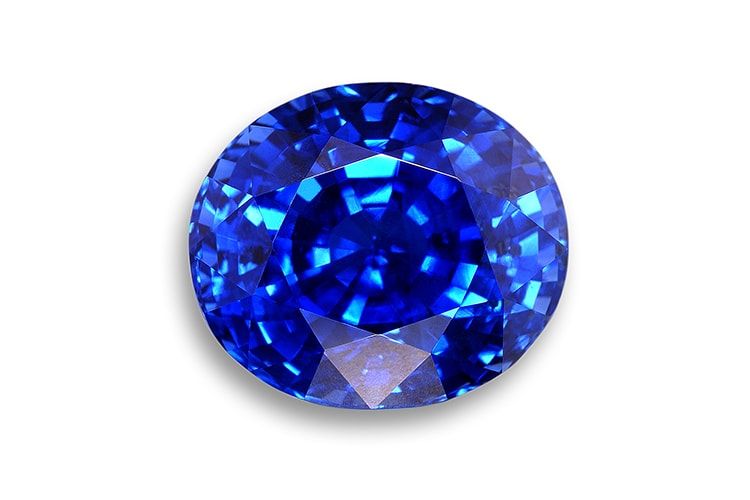AGTA Guide to Sapphire

Romance, History & Lore
Sapphire has been regarded for centuries as the ultimate blue gemstone. Ancient Persian rulers believed that the earth rested on a giant Sapphire and that its reflection colored the heavens blue. Even the jewel’s original Latin name, “Sapphiru,” means blue.
But like the endless colors that appear in the sky, Sapphire is also found in nearly every shade, from the gold of sunrise, to the fleeting violet of twilight. Sapphire may even resemble the pale white gloom of an overcast day. These diverse colors are referred to as “fancy” color Sapphires. The gift of a Sapphire symbolizes a pledge of trust, loyalty, and sincerity. It is from this tradition that Sapphire has long been a popular choice for engagement rings.

Origins
Lending to Sapphire’s enduring popularity is its presence in nearly every corner of the earth. In Asia, well-known sources of Sapphire include Myanmar, Cambodia, Thailand, Laos, Vietnam, Sri Lanka, and Kashmir. African deposits in Kenya, Tanzania, Nigeria, Madagascar, and Ethiopia provide brilliant Sapphires of every color. Additionally, Australia has been a steady source of Sapphires for years. The United States, particularly Montana, also boasts sizable deposits.
Special Properties
Sapphire, like its sister ruby, is a member of the Corundum species. In their natural form, Sapphire crystals take a hexagonal, double-pyramid shape reminiscent of a barrel. They are the second-hardest of all gemstones, second to the diamond.
Enhancements
Because of the great variety of treatments Sapphire often undergoes, it is almost impossible to list them all. Heat is the most common treatment applied to Sapphires. Gentle heat is applied to the gemstone for a period of time, resulting in a Sapphire with improved clarity and color. Heat treatment is permanent and will endure the lifetime of the gemstone. A new process that artificially alters a Sapphire’s color is diffusion, during which beryllium or a similar element is diffused onto the surface or throughout the gemstone. Diffusion-treated Sapphires—available in orange, pinkish-orange, yellow, and blue—are much more affordable than untreated or heat-treated Sapphires. Re-cutting or re-polishing may affect the color of diffusion-treated gemstones. Any treatments or enhancements that a Sapphire has undergone should be disclosed on the gem’s bill of sale. Many treatments are not easy to detect in this gemstone, so if a Sapphire is not certified untreated, it’s best to assume it has undergone some sort of enhancement, usually heating.
Selecting a Stone
The most significant factor in a Sapphire’s price is its color. Natural, untreated pure blue Sapphires, ranging in color from deep navy to icy blue, are considered the rarest and most valuable Sapphires by gemstone experts. However, they also represent a very small portion of the market. Fortunately, Sapphire’s range of color, size, and place of origin makes it an appealing and accessible choice of gemstone.
Genuine Kashmir Sapphires are the most cherished variety of this jewel. A deep, rich blue, Kashmir Sapphires are more evocative of velvet than of stone. Burmese Sapphires are also highly valued for their deep blue hue. Ceylon Sapphires, hailing from Sri Lanka, are a lively and slightly violet “cornflower” blue. After color, size and clarity are the most significant factors affecting a Sapphire’s value. As with all gems, the larger, clearer, and more flawless a Sapphire is, the more expensive it will be.
Care
As with all jewelry, Sapphire pieces should be removed at night. When using commercially-made jewelry cleaner, coat the jewelry for a few minutes, then use a soft brush to dislodge accumulated grime. Let dry on a soft cloth and store. A gentle solution of warm water and gentle dish detergent also safely cleans Sapphire jewelry. Let the piece “sleep” overnight in a basin of water with a drop or two of detergent. In the morning, use a soft brush to clean the back of the gemstone, and its sparkle will return immediately. Take care to not leave Sapphire submerged longer than overnight, and avoid submerging beads, cloth, or cord. To clean strands of beads, wipe them with a wet cloth after each wear. Additionally, most Sapphires will also withstand the vibrations of a professional jeweler’s ultrasonic cleaner, provided that the gemstone has no fissures. Avoid steam.

Source: American Gem Trade Association